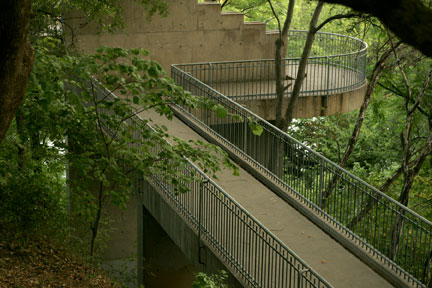Heritage Park in downtown Fort Worth may be coming back to life, two years after it was closed to the public. And the rebirth is a product of the joining of forces of historic preservationists and downtown business leaders, two groups who have not always been on the same page on this contentious issue.
When the historic park was fenced off and padlocked two years ago, there were no public hearings before boards, commissions, or the city council. City staffers cited safety issues (lack of fences and too much public access to water pools), too many homeless people congregating in the park, and the deterioration of infrastructure, mostly plumbing fixtures.
But historic preservationists thought there was a hidden agenda. The city’s parks department had been uneasy about parks with water features since the drowning deaths at the Water Gardens in 2004. The feeling was that the city purposely did not maintain the water features at the park so that the only apparent choice would be to shut it down.
“From the beginning there was an education aspect to this issue that we were up against,” said Jerre Tracy, president of Historic Fort Worth Inc., a nonprofit preservation organization. “Most people, including downtown business leaders, thought this park was an eyesore and a place for the homeless.
“But we have worked hard to show people in Fort Worth that this park was created by a nationally acclaimed architect to celebrate the nation’s bicentennial, a place on the bluff that celebrates where Fort Worth was founded and a unique design that has historic significance,” she said.
Downtown Fort Worth Inc. President Andy Taft said the initial closing “was not at the top of the radar screen” for downtown business interests. “There was certainly a lack of knowledge,” he said. “But there certainly has been some education, and we have always known the importance of public space in the downtown area.
“This is not just about closing the water features section of Heritage Park,” Taft said. “It is about the more than 100 acres that define the riverfront.”
While there is still an uphill battle to get the park reopened, a lot has changed in the past six months. Bowing to local outrage – particularly from philanthropist Ruth Carter Stevenson – as well as national attention that put Heritage Park on a list of endangered historic places, the city appointed a steering committee to assess what was needed. The city also took the decision-making process away from the parks department and gave it to Assistant City Manager Fernando Costa.
At workshops earlier this year, the committee and other interested parties heard from famed Philadelphia-based landscape architect Laurie Olin on what restoration options might be best for the historic park. But funding is a major issue, and private foundations and Fort Worth’s corporate community will be called upon in coming months to fund the first phase of study.
Olin estimated that it will cost $1.2 million to do survey work and put together a plan to improve access and fix the infrastructure. Due to initial funding issues, he will concentrate on the park’s access to downtown and not to the Trinity River.
“The key issue we have to look at first is to connect the park more effectively with the city,” Costa said. “Because of the streets that surround it, pedestrian access has always been a problem. But with Tarrant County College on both sides of the park now, this part of downtown is changing, and the redesign has to work within those changes.”
Stevenson’s Amon G. Carter Foundation has announced that it will donate $500,000 for Olin’s study. Taft will work on raising the remaining $700,000 from the Fort Worth philanthropic and business community. “I think in the next few months we’ll have a pretty good idea on the fund-raising effort, and Laurie Olin will be able to get started on his study, conceivably by the first of next year,” Taft said at a recent meeting of the committee. “But this is a marathon, not a sprint, and we need to make sure things are done right.”
The committee has already put together a pamphlet to attract private donations. “The situation is dire,” it reads. “… Will you help us preserve this important piece of Fort Worth’s heritage and make it a vibrant destination for a new generation?” A new web site will be launched (www.heritageparkfortworth) within a month.
Two recent developments should aid in the fund-raising effort. Fort Worth City Council passed a resolution last month backing the restoration efforts “and, as financial resources permit … implementing such recommendations.” And on Sept. 19, the Texas Historic Commission will hold a hearing to decide whether Heritage Plaza should be listed on the National Register of Historic Places. The listing does not assure any public grants, but it does make it easier for the park to qualify for state or federal funding.
No one knows what the price tag on renovations might be. A study paid for by the local nonprofit Streams & Valleys Inc. estimated it at $7.3 million. That report, by the engineering firm Carter & Burgess Inc., said all the electrical and plumbing infrastructure would have to be replaced, some of the concrete walls torn down and rebuilt, fencing erected around the water features, and accessibility for the handicapped improved.
But some think the engineering estimate was way too high. “Sure, there are improvements that need to be made, but much of the park is still in pretty good shape,” said Lisa Lowry, board chair of Historic Fort Worth Inc. “Access is a big issue, but I don’t think we need to tear everything down and rebuild it.”
Famed landscape architect Lawrence Halprin was approached by Stevenson , Streams & Valleys, and the city in the mid-1960s to design a park that would commemorate the nation’s 1976 bicentennial. Halprin is known around the world for his work: the FDR Memorial in Washington, Ghirardelli Square in San Francisco, promenades in old sections of Jerusalem, and water parks in many countries. In 2002 he was awarded the prestigious National Medal of Arts by President George W. Bush.
Halprin’s work, however, has not been without controversy, particularly in the design of Heritage Plaza. There is not much open space, aside from the deck on the bluff above the Trinity River. Halprin also created a series of concrete-walled “rooms,” each with a water feature. But many people don’t feel comfortable in such enclosed spaces downtown.
Access is tricky. Traffic coming north from the Paddock Street Viaduct (the proper name of the North Main Street bridge) into downtown discourages pedestrians from reaching the park, thus disconnecting it from downtown. The exterior walls also hide the park’s existence from many would-be visitors.
But those participating in the workshop said a number of solutions have been suggested. With the Charles Tandy statue now removed from tiny Paddock Park – which sits between the Tarrant County Courthouse and Heritage Plaza – there is some talk of connecting the two parks. This could be done by closing the street that separates them or possibly by building a pedestrian bridge over the street.
Whatever the solution, the historic preservationists and downtown business community are finally seeing some progress. “Andy Taft is right,” said Tracy. “This is a marathon and not a sprint. But we are seeing city council and the business community and those of us in historic preservation come together to realize that closing down such an important place in this city is just not good policy.
“It’s been two years since the fences were put up, but we think we’ve turned it around,” she said. “Still a lot of work to do, though.”











